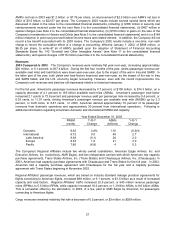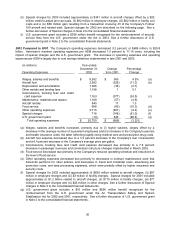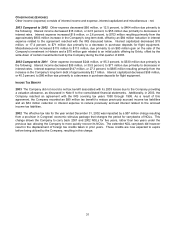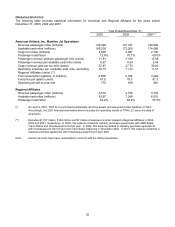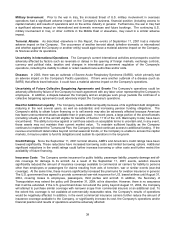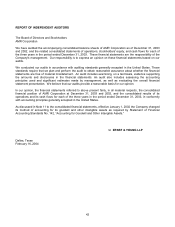American Airlines 2003 Annual Report Download - page 36
Download and view the complete annual report
Please find page 36 of the 2003 American Airlines annual report below. You can navigate through the pages in the report by either clicking on the pages listed below, or by using the keyword search tool below to find specific information within the annual report.34
Long-lived assets – The Company has approximately $20 billion of long-lived assets as of December 31,
2003, including approximately $19 billion related to flight equipment and other fixed assets. In addition to
the original cost of these assets, their recorded value is impacted by a number of policy elections made by
the Company, including estimated useful lives and salvage values. In accordance with Statement of
Financial Accounting Standards No. 144, “Accounting for the Impairment or Disposal of Long-Lived Assets”
(SFAS 144), the Company records impairment charges on long-lived assets used in operations when events
and circumstances indicate that the assets may be impaired, the undiscounted cash flows estimated to be
generated by those assets are less than the carrying amount of those assets and the net book value of the
assets exceeds their estimated fair value. In making these determinations, the Company uses certain
assumptions, including, but not limited to: (i) estimated fair value of the assets, and (ii) estimated future cash
flows expected to be generated by these assets, which are based on additional assumptions such as asset
utilization, length of service and estimated salvage values. A change in the Company's fleet plan has been
the primary indicator that has resulted in an impairment charge. The Company recorded impairment charges
related to its Fokker 100, Saab 340 and ATR 42 aircraft in 2001 and 2002. In 2003, the Company recorded
an impairment charge related to its Airbus A300 aircraft as a result of accelerating the planned retirement of
this fleet. In addition, in 2003, the Company recorded impairment charges related to its Boeing 767-200
aircraft and four of its Boeing 767-200ER aircraft as a result of permanently retiring these aircraft. Also in
2003, the Company analyzed its remaining Boeing 767-200ER aircraft and determined that these aircraft
were not impaired based on anticipated future cash flows. See Notes 1 and 2 to the consolidated financial
statements for additional information with respect to these impairment charges and each of the policies and
assumptions used by the Company which affect the recorded values of long-lived assets.
Passenger revenue – Passenger ticket sales are initially recorded as a component of Air traffic liability.
Revenue derived from ticket sales is recognized at the time service is provided. However, due to various
factors, including the industry’s pricing structure and interline agreements throughout the industry, certain
amounts are recognized in revenue using estimates regarding both the timing of the revenue recognition
and the amount of revenue to be recognized, including breakage. These estimates are generally based
upon the evaluation of historical trends, including the use of regression analysis and other methods to model
the outcome of future events based on the Company’s historical experience and are generally recognized at
the time of sale. The Company’s estimation techniques have been applied consistently from year to year.
However, due to changes in the Company’s ticket refund policy and changes in the travel profile of
customers, historical trends may not be representative of future results.
Frequent flyer program – The Company uses a number of estimates in accounting for its AAdvantage
frequent flyer program. Additional information regarding the Company’s AAdvantage frequent flyer program
is included in Part F of Item 1 of this Report. Changes to the percentage of the amount of revenue deferred,
deferred recognition period, percentage of awards expected to be redeemed for travel on participating
airlines, cost per mile estimates or the minimum award level accrued could have a significant impact on the
Company’s revenues or incremental cost accrual in the year of the change as well as in future years.
Pensions and other postretirement benefits – The Company’s pension and other postretirement benefit
costs and liabilities are calculated using various actuarial assumptions and methodologies. The Company
uses certain assumptions including, but not limited to, the selection of the: (i) discount rate, (ii) expected
return on plan assets, and (iii) expected health care cost trend rate.





